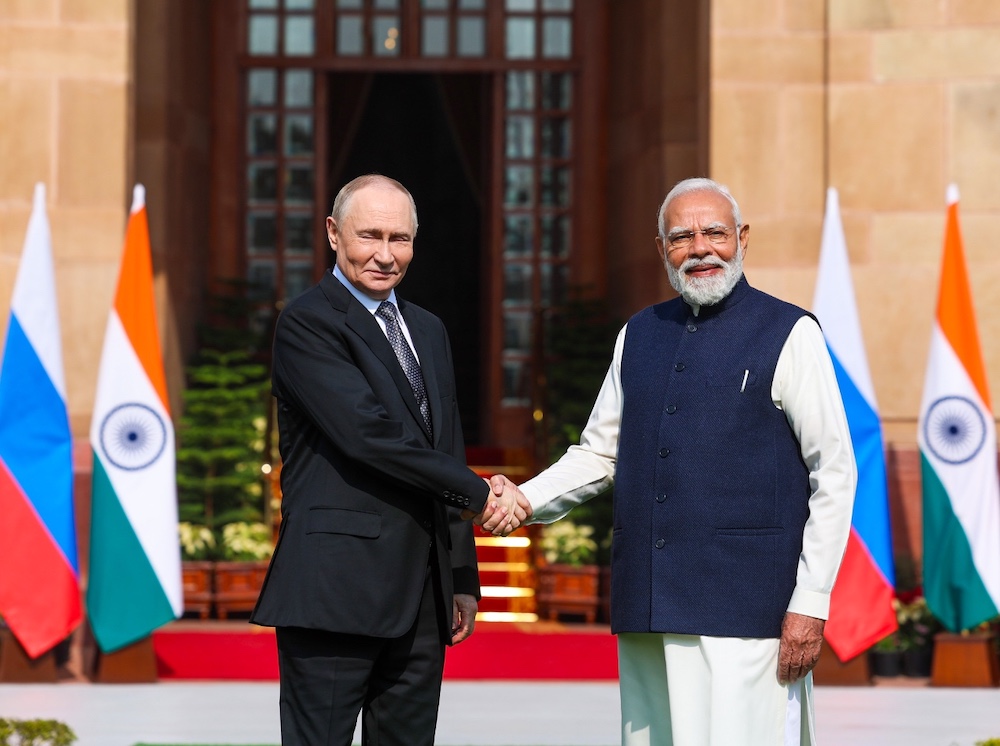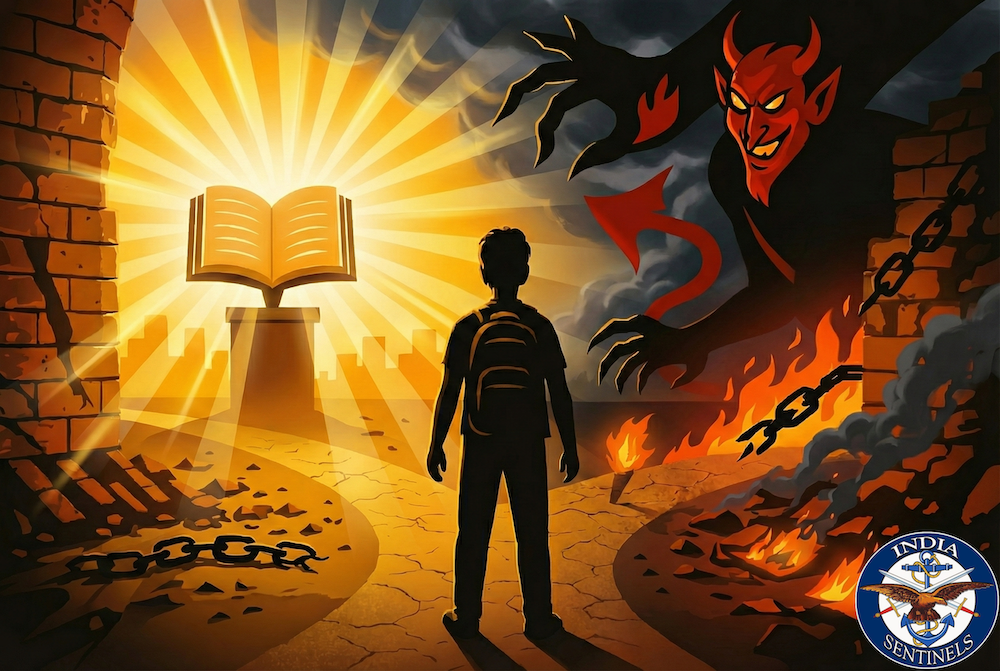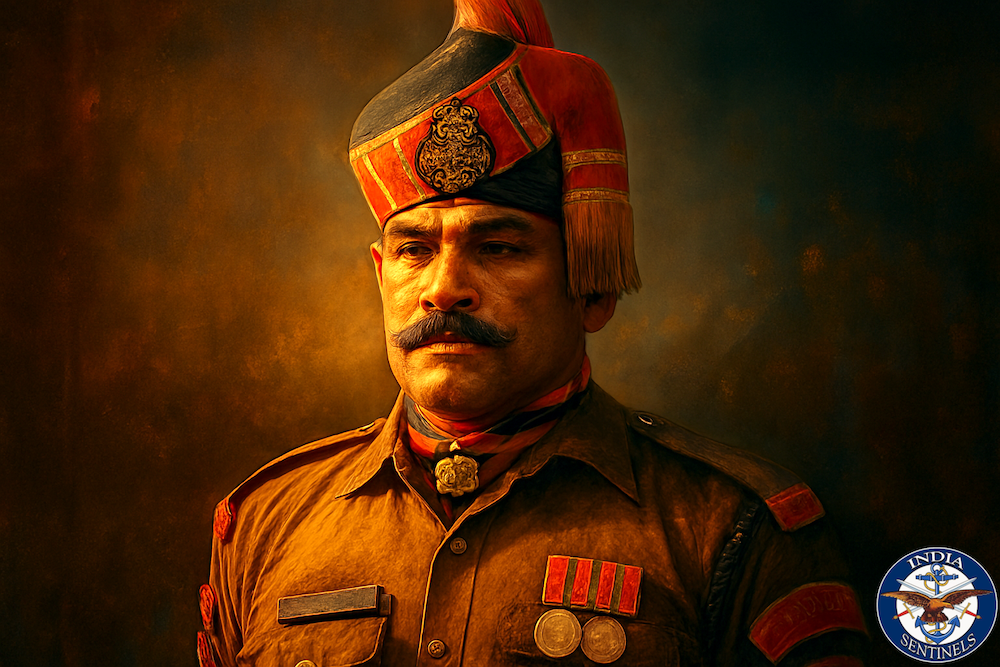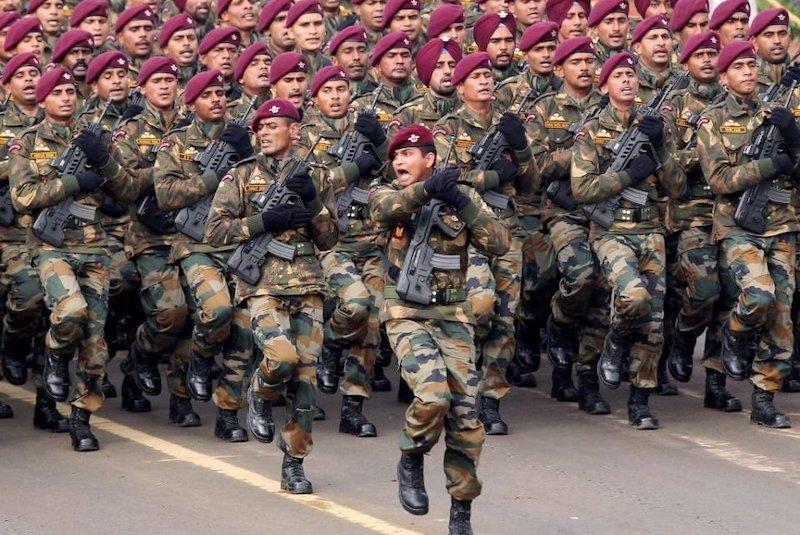 Commandos from Indian Parachute Regiment during a Republic Day parade.
Commandos from Indian Parachute Regiment during a Republic Day parade.
Not so long ago, we, as Indians, were sure about our military dominance in South Asia. We were proud – and also cocky to an extent – about our status as the “regional superpower” and took it for granted. However, those days are gone. Today, we have to try hard to convince anyone who is willing to hear the stories of how we have pulled this and that off.
Sitting in the gloom of 2020, battered by the Chinese virus at home and pushed around by the Chinese forces on the LAC (line of actual control), we desperately need feel-good stories about us.
While we cannot create good news, we certainly can remember good times – real memories of real glory, which made us proud then; and which would cheer up those who have never seen such exploits of the Indian armed forces.
Once upon a time in Maldives
Today, let’s take you back to the winter of 1988 to one such story of grit and glory, seen through the eyes of Brigadier RJS Dhillon (retired), the soldier who was at the forefront and in the thick of action while history was being made. The veteran paratrooper was a major then and was at the spearhead of India’s strike force that carried out the sensational airborne commando operation in the Maldives – Operation Cactus, on November 3, 1988.
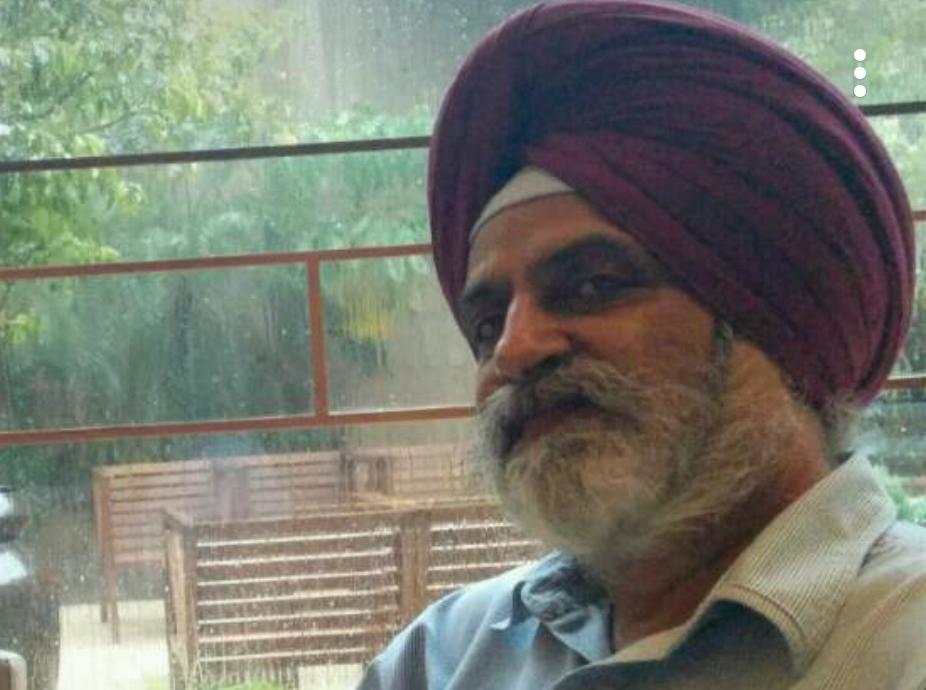 Brigadier RJS Dhillon (retired), who was a major during the 1988 Operation Cactus, was at the forefront of India’s strike force in the operation.
Brigadier RJS Dhillon (retired), who was a major during the 1988 Operation Cactus, was at the forefront of India’s strike force in the operation.
His version of the events that led to the operation and the operation itself brings out hitherto untold aspects of that story – the sinister conspiracies, the glitches in planning and preparations, the decision-making crossroads and controversies and also the colourful asides and vocabulary of officers and gentlemen under stress.
The Backdrop and the Plot(e)
The People’s Liberation Organization of Tamil Eelam – one of several secessionist Tamil groups fighting for a separate homeland in Sri Lanka during that time – appeared to have developed close ties with the Lankan government, which saw the LTTE as its main enemy and had an axe to grind against India for its support to the country’s Tamil cause. At that time, Junius Richard Jayewardene was the president of Sri Lanka.
In 1988, Abdullah Luthufi, a fugitive Maldivian rogue businessman, in connivance with Ibrahim Nasir, the Maldives’ former president, reportedly conspired with elements in the Lankan state apparatus to organize a coup d’état in the Maldives and overthrow the government of the-then president, Maumoon Abdul Gayoom, using PLOTE gunmen as mercenaries.
According to Brig Dhillon, the conspiracy was hatched in a poultry farm near Colombo with a Lankan brigadier general, who headed their military intelligence (MI). The mercenary consideration for PLOTE was the promised lease of one of the northern Maldivian islands, after the new regime replaced Gayoom. The PLOTE would then run drugs, gold and arms into India from this base.
Although this has never been talked about officially, the fact remains that Gayoom reached out to Sri Lanka (among other countries) on the night of 2-3 November for help. He was refused despite Sri Lanka being the Maldives’ closest neighbour and they had special forces standing by for emergencies. According to Brig Dhillon, the PLOTE mercenaries hijacked a vessel and sailed it through Lankan waters, which were heavily patrolled by their navy.
These facts spin their own mystery.
During the night of 2-3 November, a PLOTE contingent of over 80 heavily armed mercenaries landed at Male harbour. According to some accounts, they joined another group which had previously infiltrated into Male. By dawn, they took over all important installations, like the presidential palace, radio station, telephone exchange and laid siege to the “fort” which housed the Maldivian NSS (National Security Service). They cut off all communications and imposed a curfew.
By then, Gayoom had been moved out from his residence and hid in the humble servants’ quarters of a villa, along with his family.
As the coup unfolded with the president going into hiding, one thing saved the day for the Gayoom regime. The Male telephone exchange had a backup line that was connected to batteries for power and was accessible to the president’s personal assistant. The line was routed through Singapore.
The president’s PA contacted countries far and near – from the US, UK to Pakistan and Lanka and Singapore. No one was prepared or able to help. According to other accounts, the US pleaded the 1,000km distance between their nearest base at Diego Garcia and the Maldives for their inability to move in early.
A Friend in Need
Finally, the PA called the Indian Prime Minister’s Office. Rajiv Gandhi, who was the prime minister then, was at Patna at that time. He returned to New Delhi at night and had an emergency meeting on the ongoing coup in the Maldives.
Brig Dhillon says, “Fortunately the PMO was very agile those days and they immediately consulted the Indian high commissioner to the Maldives, Ashok Banerjee, who happened to be in Delhi on leave, at that time. A message was immediately sent back to the Maldives government that India has accepted their request and would do the needful. This was early on the morning of 3rd (November).”
Initially the task was given to the National Security Guard, who expressed their inability to carry it out when they were briefed about the actual situation on the ground. They suggested that the Army be roped in instead. Around 7.30–8 in the morning, the Indian Army was intimated about the task.
General Vishwa Nath Sharma, who was the chief of the Army staff then, took the briefing and tasked Lieutenant General Sunith Francis Rodrigues, the vice-chief of the Army, to mobilize the 50 Para Brigade for the operation, while he proceeded to the Military Operations Room (MO).
The Military Planning, Preparations and Controversies
According to Brig Dhillon, who was a major at that time, the hotline from the MO to the Para Brigade, at Mathura, was down. And in his opinion, the Army vice-chief, having failed to get through to the brigade at the first go, and in his hurry to get to his office, “forgot” to follow up on this. As a result, the Para Brigade received word of the task not before 10-10.15 in the morning.
Brigadier FFC Bulsara, commander, 50 Para Brigade, was out of his base at that time. Brigade Major Vinod Bhatia (later director general military operations) took the call and was told: “Get ready for airborne operations. 1 Company to move at two hours’ notice. More orders to follow.”
At that moment, the brigade’s units were situated thus:
1. 7 Para was away on training at a location 80 kilometres away.
2. 3 Para was across the Yamuna, closer, on training.
3. 6 Para had just returned from counterinsurgency operations in Manipur earlier that year, in February.
To be noted here that Brigade Major Vinod Bhatia (later retired as lieutenant general) was originally from this unit and Major Dhillon himself was then the officer commanding of the Charlie (“C”) Company of 6 Para.
Brigade Major Bhatia, passed on the orders to the CO 6 Para, Colonel (later Brigadier) SC Joshi.
Within 6 Para, the situation was like this:
The Charlie Company (C Coy) had completed their individual training cycle by the end of October. They had now been fully trained to operate from the IL-76 aircraft. Maj Dhillon, OC, C Coy, was supposed to go on leave in a few days’ time and was busy writing the ATR (after-training report). After having completed the training cycle, the C Coy had been assigned as the “duty company” as per the unit drill. On that day, his men were spread out over the 3 railway stations near Agra to collect stores and his vehicles were all being made ready for CME inspection.
The Delta Company (D Coy), which had the highest manpower strength in the unit, was away to guard the COD (Central Ordnance Depot), 5km away, having received intel that Punjab militants may target it. They too were called back.
At around 10.30am, Maj Dhillon was on a tea break, when the unit CO, Col Joshi called him in and intimated him about the operation and instructed him to alert his company and accompany him to the brigade headquarters (BHQ) for briefing. The regimental quartermaster (RQM), Captain Bahl, was tasked to round up all the effectives of C Coy from around Agra and bring them in.
Arriving at BHQ, the situation, as known then, was communicated to them and C Coy was assigned as the pathfinders to spearhead the assault, they would para-jump on the target, while the rest of the unit was to be air-landed. The D Coy would follow the C Coy and then the rest of the support and admin group. Three IL-76 heavy lift aircrafts would be made available at the first go, to be followed later by an assortment of other planes.
The island on which the Maldives capital, Male, was based was thought to be too small for the whole company to jump safely. Therefore, it was decided that the details would be worked out in the final briefing at the airfield, to be conducted by representatives from Army Headquarters (AHQ).
Subsequently, the preparations were made, equipment, ammunition, vehicles were organized and other essentials for the commandos’ paradropping were prepared. The paratroopers were gathered and brought over to the Agra airfield. By the time C Coy could move to the airport, it was already past 1.30pm. The company was assembled near the 44 Squadron (the IAF unit that would airlift the paratroopers and their equipment) dispersal area. It was right next to the base operations room, where the final briefing would take place.
After assembling, Maj Dhillon went back to pick up his RCL vehicle (recoilless gun mounted on a small vehicle, meant for taking out heavy vehicles, including armoured vehicles), which was being fitted out for the airlift and headed back for the airfield. He saw two officers standing by the runway, looking for a lift to 44 Squadron. They turned out to be the-then deputy director general military operations (DDGMO), Brigadier Ved Prakash Malik (later general and chief of Army staff) and Air Marshal Goel, then director transport and maritime ops (DTMO) of the Indian Air Force.
Once all of them arrived at the 44 Squadron operations room, the final briefing was given by the DDGMO. Brig Malik said: “Gentlemen there has been a coup in the Maldives – mercenaries, with one mother ship in unknown numbers, perhaps between 400–550 men, with rocket launchers, automatic weapons, have taken over the (Male) town, imposed curfew, cut off telephone connections, except for a tenuous line. The airport (Hulhule) is on another island – a kilometre away from the capital. You will jump your company into a football stadium in the capital.”
Maj Dhillon objected. He said with full loads, a company-sized drop couldn’t happen in a stadium-sized enclosed area.
That followed an agitated discussion and Brig Malik suggested that paradrops had happened in a stadium during the (1982) Asiad! Maj Dhillon shot it down saying that such stunts can’t be tried with heavy loads and the aircraft would have to make an infinite number of passes over the stadium for all the troops to jump.
Then Group Captain Goel (the outgoing CO, 44 Squadron, who had just handed over charge to Group Captain Bewoor, son of Gen Gopal Gurunath Bewoor) suggested a compromise. He said that the paradrop could be tried in the reclamation area of the capital’s island.
This too was found unacceptable by Maj Dhillon since the drop zone would be too small (250 yards X 100 yards) and the paratroopers would end up in the sea! When asked for an alternative plan, he suggested an air-landing at the Hulhule airfield.
When the objection came that the airfield could already be in the hand of hostiles, he suggested that in that case they would para-jump into the airport perimeter and take it over, secure the runways for the rest of the force to be landed. He further surmised that if the mercenaries were occupying the airfield then it stood to reason that they must have used boats to arrive in the first place (it being on an island), so the same boats could then be commandeered by his paratroopers to reach Male.
The situation got tensed.
Sensing that, Brig Bulsara stepped in, and according to Brigadier Dhillon, talked to Malik to calm down.
In his stentorian voice, Brig Bulsara said, “Malik, sit down, I will take it from there.” He then asked the DDGMO, “Malik, what is my task?”
(This basic question hadn’t even come up in any of the briefings since morning.)
To this, Brig Malik laid down the objectives:
1. Rescue the president, Maumoon Abdul Gayoom
2. Restore the government, if possible
The conversation was as follows:
Brigade commander Brigadier Bulsara: “Where is the president now?”
DDGMO Brigadier Malik: “We don’t know!”
Brig Bulsara: “Is he alive”?
Brig Malik: “We are not very sure.”
Brig Bulsara: “If it is to be done, this is the way we will do it.”
Then Bulsara turned to Group Captain Bewoor, the IAF officer who would actually be flying the lead aircraft (IL-76) carrying the paratroopers, and said: “You will land my lead company. If there is any hostile presence on the airfield, you will turn around and drop them. They will capture the airfield; the Number 2 aircraft will follow and land, and then we will proceed further.”
Now, the DDGMO objected. The conversation was something like this:
DDGMO Brigadier Malik: “No, this is not the way it has been told by AHQ, you can’t do it like that! I can’t sanction a change in plan.”
Brigade commander Brig Bulsara: “Who can?”
DDGMO: “The vice-chief (of the Army staff).”
The operations room was then cleared and only the following stayed back:
1. Brigadier VP Malik, DDGMO
2. Brigadier FFC Bulsara, brigade commander, 50 Para Brigade
3. Colonel SC Joshi, commanding officer, 6 Para
4. Major RJS Dhillon, officer commanding, Charlie Company
5. The two IAF group captains, including Group Captain Bewoor
Next, a call was put through to Lt Gen Rodrigues, VCOAS, at AHQ, on speaker phone. The conversation went like this:
Brigade commander FFC Bulsara: “Sir, Bul here. I have been briefed by Ved and this is the way (explaining his plan) I want to do it, this is the way it can be done.”
VCOAS Lt Gen SF Rodrigues: “Bul, are you as thick as ever?!”
Brigade commander: “Sir that is neither here nor there ... if you want it to be done, this is the way it is to be done, otherwise you find another man!”
VCOAS: “OK, it’s your funeral!”
With this, he firmly put the ball in Brig Bulsara’s court and washed his hands off it.
And the brigade commander, after putting down the phone, went like this: “Gentlemen, we will land!”
That was it. He took it upon himself squarely, the whole responsibility and accountability for the outcome of his plan, in the face of institutional opposition and scepticism.
According to Brig Dhillon, Lt Gen Rodrigues (later general and Army chief) was in a bit of a jam since he had delayed the alerting of the Para Brigade. For this, he was taking the heat from the defence secretary and others. The prime minister, Rajiv Gandhi, had discontinued his tour and rushed back to New Delhi from Patna to monitor the situation. Gandhi wanted minute-to-minute briefings on this. Dhillon has the highest praise for Gandhi on these issues. Dhillon feels the VCOAS was trying hard to cover his tracks for the delay.
The Men, Stens and Planes
So far, for security reasons, no one outside that operations room had been briefed about the exact nature of the operation and the destination. Families had been told that they were headed to Sri Lanka (the Indian Peacekeeping Force operations were still under way). Now the final touches were out to the preparations. Extensive briefings given to the men. Dhillon found that to beef up his strength, eight fresh soldiers who had never even received their jump training yet had been sent from the Para Regimental Centre. He also received more help, like the second in command (2i/c), Captain MK Singh, was deputed from the Bravo (“B”) Company of 6 Para as a substitute for his own 2i/c, who was away on training.
His total jump strength that day was not more than 65 men, all ranks, since that was the total number of kits for the para jump available with the brigade!
Next came the issue of weapons to be carried for the jump. Normally for jumping from Il-76, only sten carbines were authorized to be carried as personal weapons. Officers and JCOs would have jumped with LMGs and MMGs, on the personal responsibility of the Company OC, while the air force looked the other way! Now that a normal air landing was a possibility, Dhillon ordered normal infantry weapons, from rifles to medium machine guns, to be loaded for everyone with ammunition and other paraphernalia.
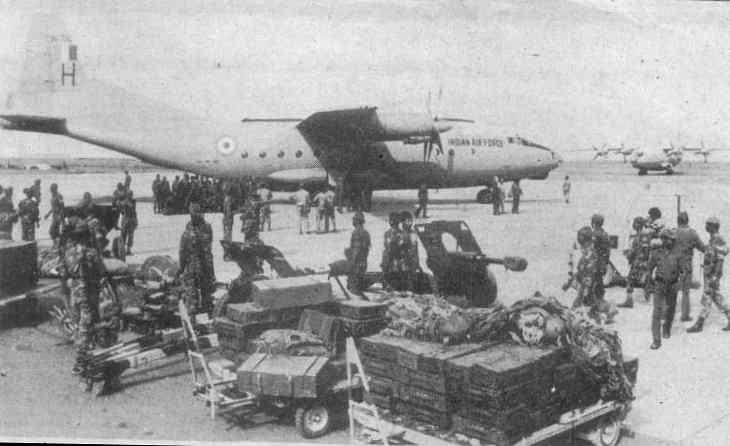 Indian paratroopers at the Male airport during Operation Cactus.
Indian paratroopers at the Male airport during Operation Cactus.
Dhillon feels that as per normal protocol, the chain of command for this sort of an airborne operation would involve the Corps HQ and Air Force Command, formations closer to the reality on the ground. But here the micromanagement was happening from AHQ – by people who were far from the minutiae of field ops and hence “blissfully unaware” of the actual requirements, like weapon loads allowed, etc. Therefore, these decisions, and deviations like carrying LMGs/MMGs during a jump, rested on the shoulders of officers at the spot.
The jump, if it came to that, would involve the chutes opening at around 1,200 feet as per the IL-76 jump protocol. Dhillon says that he budgeted for up to 25 per cent of his men drifting into the sea in case the jump went even slightly wrong, so narrow was the margin. The 3-kilometre-long single runway was only 100 yards wide. They had no information on the wind strength.
And finally came the revelation that of the three IL-76s promised for the first phase of the mission, only two were available – dubbed as “Friendly 1” and “Friendly 2”.
The first plane had Charlie Company and elements of Delta Company, elements sent from other units, like 3 Para; Col Joshi CO, 6 Para; Brig Bulsara, brigade commander, 50 Para.
“It was filled to the gills,” according to Dhillon. The second plane carried the rest of Delta Company, elements of 3 para (company, with their OC, Major (later Lieutenant General) NKS Ghei, Bgde HQ, CO 17 Para Field Regiment (CO Col KK Singh) and the Brigade Major Vinod Bhatia. (However, elsewhere, Lt Gen Bhatia, who was a major then, mentions that he was in the lead aircraft with the GSO3. We must remember that these are recollections of events that took place 32 years ago.)
The two IL-76 aircraft took off around 5pm (5.30pm as per Lt Gen Bhatia’s account). The landing/drop plan was that the lead IL-76 would approach the airfield and attempt to land. If it was found to be in enemy hands, the crew would abort the landing and turn away. It will then come in at a jump height and drop the paratroopers designated to jump. Then it will turn around and come back for landing with the remaining elements once the runway was clear of interference, if any. After that, the second plane would land the rest of the brigade.
The code word set up with the Hulhule airfield ATC was “Hudiya”. The ground crew were supposed to put on the landing lights on the runway briefly for the aircrew to align the landing and then switch off again. The flight time from Agra to Maldives was 4am–4.30am. And then finally the paratroopers took off for their mission – within seven hours of being alerted.
The ‘Shatrujeets’ arrive
After 9.30pm, the lead aircraft arrived above Hulhule airfield and received the “Hudiya” code word from the ATC.
Now was decision time. “Was the code given under duress by the ground staff?” “Was the airfield under hostile control?” “Should the plane land?” These were some of the questions going in the minds of the commandos.
Brig Bulsara took the call to land.
The runway lights came on briefly as planned. The plane touched down and even before it came to a halt, Brigadier Dhillon and his men started getting off the plane with their loads. Readers familiar with war movies, can perhaps visualize that supreme moment of an airborne assault, when the force hits the ground expecting anything and everything out there.
In this case, there was no hostile fire at all after the paratroopers landed.
Dhillon rushed the airport terminal and put a guard in the premises and then ran to the ATC tower. Inside he found a person talking over the radio, who identified himself as an ATC personnel. He got the person lined up against the wall and debriefed him, after introducing himself. In the meantime, there was the noise of gunfire and explosions (bangs) coming from across the harbour in Male, a kilometre away.
The ATC staff member claimed that he was talking over radio, to the Maldivian National Security Service HQ in Male. Dhillon took over the communication and spoke to the NSS major, who was the duty officer, on the other side, who sounded rather rattled.
NSS major: “Please hurry they have fired a rocket launcher into the wall of the fort and made a hole”.
Maj Dhillon: “Don’t worry. Do you have a GPMG (general purpose machine gun)?”
NSS major: “Yes.”
Maj Dhillon: “Please cover the breach with the GPMG and then plug it with sandbags. We will arrive soon, in strength.”
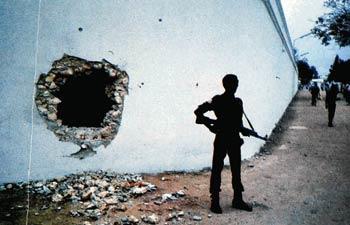 The hole made by an RPG on the wall of the NSS fort in Male.
The hole made by an RPG on the wall of the NSS fort in Male.
Meanwhile, others, including the IAF officers arrived at the ATC. Dhillon left the tower and came out on the airfield. By that time, the second plane had landed, and he was asked by Brig Bulsara to hand over the airfield perimeter to Major Ghei’s men of 3 Para, proceed on the primary mission to Male, that is, locating and securing the president.
A secondary diversion was to be created by sending a boat under Maj Ghei to the other side of the harbour.
The C Coy ran up to the jetty and found 5 or 6 speedboats that can carry 5-15 personnel each. They had two engineers with them, one to go with the first boat and one with the last in sequence. The first boat was supposed to carry Capt MK Singh, Dhillon’s 2 i/c for the occasion (on loan from Bravo Company). However, since that boat was taking time to manoeuvre, Maj Dhillon took his boat to the head of the convoy. Since his boat was now the first in sequence, the engineer from the originally designated first boat (Capt MK Singh’s) transferred himself to Dhillon’s boat.
This minor incident would lead to a rather humorous mix up later.
While moving to Male, they cut across the wake of a ship hijacked by the PLOTE mercenaries, making a getaway in a hurry. Unknown to 50 Brigade, an Indian Navy IL-38 had made a low pass over Male sometime back. That had spooked the mercenaries in the first place. On top of that when they heard the IL-76s noisily approaching Hulhule airport, they realized the game was up. That’s when they hijacked this ship and most of them bolted with some hostages.
Finally, the boats reached the western side of the main island (Male), and touched land, at the same reclamation area, where it had been proposed that they jump into, initially.
Maj Dhillon jumped out of the boat and found the others slightly dazed by the rough journey through choppy waters. He had to get his company havildar major (CHM) to physically throw people out of the boat! The last person at the back, was still not willing to get out. (He, unknown to Dhillon or the CHM at that time, happened to be the engineer who was supposed to take the boat back to Hulhule.)
The CHM threatened to shoot him if he didn’t get out! And finally, he too got off the boat. The landing area was secured. And they started looking for the guide (as communicated by the NSS major) supposed to take them to the president’s hideout. About 40 paratroopers had landed by that time and secured the landing area.
In the meantime, they could see a cyclist, in lungi, approaching. It was pitch dark, due to the curfew and blackout. They had no clue whether the man was friend or foe. The paratroopers pounced on the cyclist and knocked him down. It turned out that he was the designated guide!
Their first destination was supposed to be the defence minster’s house.
In the meantime, the next elements had started to build up in the landing area. Maj Dhillon left 10 paratroopers to guard the landing strip and proceeded on his mission. On the way, they came across a pickup van with keys in the ignition. They got hold of it and moved.
Col Joshi caught up with them as they reached the defence minister’s house. They were told that the president was hiding in the servants’ quarters of a house, which was just about a hundred yards from the Indian high commission.
Most of the PLOTE mercenaries had left in that hijacked ship and another team taking off in a boat. They had started loading up the ship at around 4pm, when the IN IL-38 had made the low pass over the island.
The mercenaries took hostages, they looted jewellery shops, official stores and made themselves ready to leave Male if things got out of hand. And they did so when the two IL-76 aircraft landed in Hulhule.
Mission Accomplished
By now, the paratroopers were taken to the campus where the president was hiding. It had high walls around it. At first the guard wouldn’t open the gates for them, being unsure of their identity. Dhillon considered scaling the walls in order to enter! But when the the guard spotted Sikh troops, in turbans, and that reassured him that this indeed was the Indian rescue team, he opened the gates.
The officers entered the campus – Col Joshi, Maj Dhillon, Capt Singh and the rest of the force.
The NSS guide took them to the servants’ quarters where the president was with his wife and daughter in a two-room unit. He had a small team of personal guards with him. It was obvious that his family had been through a terrible time since early morning. They were relieved to see the Indian paratroopers.
Dhillon secured the campus with a platoon under Capt MK Singh to create a misleading impression that the president was housed there. And moved off to the NSS HQ, which was housed in the fort as mentioned earlier, with the president and his family. On the way they found bodies of mercenaries fallen in firefights with NSS personnel, earlier in the day.
After the president was safely ensconced in the fort, Major Dhillon went on to clear the harbour with a small team.
It so happened that the company officer of Maj Ghei’s company, which was sent in a boat for creating a diversion to the other side of the harbour, had inadvertently come too close to the sea wall to this side of the quay. In the darkness, Maj Dhillon challenged the boat with a halt! When no answer came, he had his MMG team set up the machine gun and threatened to fire. Then the company officer, Capt Punekar, identified himself and an “incident” was avoided.
The last PLOTE group of three men, which had assaulted the NSS fort with a rocket launcher when the paratoopers were at the ATC, had made their getaway in a small boat which ran out of fuel and went aground in another island, 10km away. They were apprehended and brought back by a patrol from Alpha Company, which arrived later.
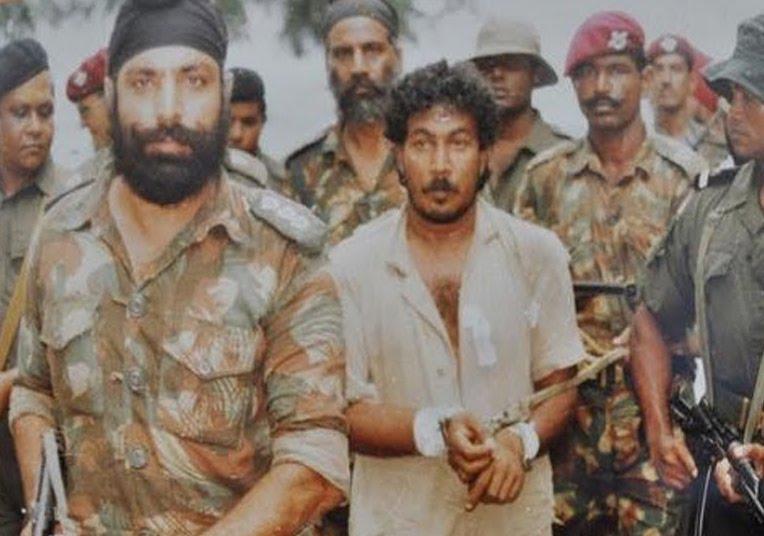 Indian paratroopers with a captured PLOTE mercenary.
Indian paratroopers with a captured PLOTE mercenary.
It turned out that the leader of the PLOTE group, Julio, was killed in the firefight with the NSS, in front of the fort (one of the bodies spotted on the way). That had demoralized the rest who needed little persuasion after that to run, once they saw the Indian aircrafts approaching.
This episode brought about a golden era in India-Maldives relationship, politically and strategically, for years to come. President Gayoom was personally grateful and showed it.
From the NSS HQ, a call was put through to New Delhi, to thank the Indian PM. The call went through the Indian defence attaché’s network in Colombo.
DA to Maj Dhillon: “Thank God you guys are there!”
Maj Dhillon: “The president would like to thank the prime minster.”
DA : “I am putting through the call to the MO (AHQ, Delhi).”
The call is patched through to the MO and Major Dhillon is on the line.
MO: “This is Rajiv.”
Maj Dhillon, who thought it was a duty officer taking the call: “Rajiv this is Major Dhillon, the president of the Maldives would like to speak with the PM.”
MO: The person chuckles and says, “Major, I am the PM!”
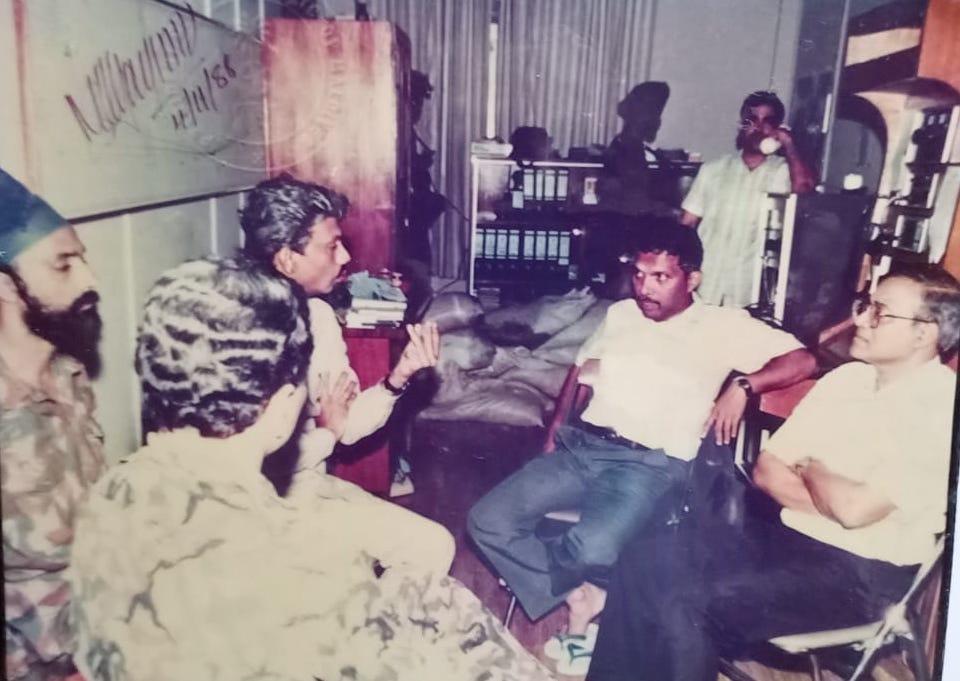 Major Dhillon (extreme left) and President Maumoon Abdul Gayoom (extreme right) at the NSS HQ.
Major Dhillon (extreme left) and President Maumoon Abdul Gayoom (extreme right) at the NSS HQ.
That was a historic moment indeed, for India-Maldives relationships, for the Indian military and the personal role of the highest executive of India, in personally monitoring a sensitive operation ball by ball. He hadn’t interfered in the military details. He had delegated a critical task of the highest national and international sensitivity to a professional military hierarchy – and had personally kept in touch with every move.
According to Brig Dhillon, the success of Operation Cactus owes itself to four people:
1. Prime Minister Rajiv Gandhi for “having the vision and political will” to give the operation go-ahead.
2. Brigadier Bulsara.
3. Colonel Joshi for “keeping away all the background clutter and allowing the assault companies to do their job”.
4. Brigade Major Vinod Bhatia, who knew that the C Coy had was fully trained to be deployed from the IL-76. Therefore, he designated this company as the pathfinders and spearhead, from the very beginning.
Brigadier Dhillon repeats his appreciation of the PM’s role and his grace. The PM had personally thanked him for the success of the mission and asked him to convey his appreciation for the role of the Indian Army.
This then is the story of one of the greatest chapters in India’s military history and geostrategic victories. This story has been told many times, by many people. There are subsequent developments that followed the action of November 3, 1988.
The mercenaries were later intercepted by the Indian Navy. Some troops from 6 Para stayed back at Maldives for security, at the president’s request. But those tales have been told in detail elsewhere.
In the entire operation, there was not even a single Indian casualty.
This story was about the cut and thrust of a daring airborne action, as seen through the eyes of the point man – the officer who spearheaded the operation, which we know as Operation Cactus today.
This also sheds light on certain controversial aspects of this operation, that laid buried until now. Brigadier Dhillon believes that these need to be put on record – for posterity to remember and for this generation to know that the Indian military has seen glory, real glory and real victories, in the good old days. Lest we forget, in the din about today’s surgical strikes, that India always has had the best fighting men and national leaders who empowered them.
Listen to the full interview of Brigadier RJS Dhillion, who talked to Sandeep Mukherjee:
[Disclaimer: Views expressed by Brigadier RJS Dhillon are his own and don’t necessarily reflect the views of India Sentinels.]


